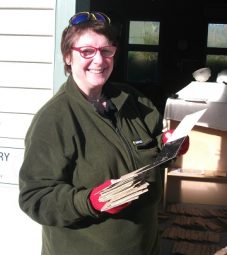Kaponga School – Helen Duff

2016 | Tiaki I to tatou Taonga
School: Kaponga School
Host: Rotokare Scenic Reserve Trust
Region: Taranaki
Kaponga School belongs to a the MOA Kluster of rural Taranaki schools along with with Matapu, Opunake and Auroa, These schools share a vision of where they want to be and that means having a STEM focus. One teacher from each school is participating in the Science Teaching Leadership Programme. These teachers will meet regularly with the aim of ‘opening up’ the way science is delivered within the MOA Kluster. This will develop continuity and collegial connectivity around the way teachers approach the delivery of the curriculum and how it is shared with the student body in an engaging, exciting, and future looking manner.
Helen has 16 years primary experience and 6 years prior to that relieving at Opunake High School. Helen currently holds SENCO, Second Languages, Performing Arts, Music, and Environmental responsibilities. She is passionate about Environmental Science and Biodiversity and how these can be a start point leading into other areas of STEM.
During her placement at Rotokare Scenic Reserve Trust, Helen spent time with a wide variety of people, many from the local community. Her host site was rich in biodiversity and time was spent exploring different facets of that. She undertook research identifying Maaori names for the Rotokare Flora list. Rotokare is extremely important to Taranaki iwi. She created two research programmes for her school, both having long term links to Rotokare and the wider community.
- During the Sanctuaries of New Zealand Conference in Hamilton, she spoke with Scott Bartlam, Landcare Research, around the possibility of creating an earthworm research project with her students at Rotokare. Both his, Simon Collins and the Educations Teams support (Melissa and Jen) was invaluable and instrumental in the developing the programme
- Additional responsibilities for her were the ‘Robin Run’. Calling, feeding, observing and noting behaviours. Reading tracking tunnel cards. Making several hundred wire baffles in response to the mouse incursion. Observing the education programme. Helping with Lizards and Meal Worms. Helen also liaised with Opunake High School Science Department around the Rotokare Education Programme to find out why and how it was used and did they have any suggestions regarding improvement.
Helen visited STLP teachers from schools like her own. This was valuable. Being in the second wave of the STLP and having two other cluster teachers in the first half was great. She was able to discuss how they delivered their programme and help cement future network opportunities. Throughout her placement Helen had opportunities to visit scientists working in other fields.
- Fuel Energy ,Methanex.
- Dairy Industry, Fonterra.
- Building Science. Her nephew, Ethan Duff, is part of a team who recently designed a building in Wellington to E4 specifications. That means it has to be still fully functioning after any earthquake or natural disaster. They are currently working on an E4 specification control room for the Methanex site in Taranaki and also a new Marae complex in South Taranaki using ecological guidelines. An interesting STEM study.
Helen also visited Rewi Elliot, Curator at Otari-Wilton’s bush, Wellington, around the possibility of Rotokare propagating threatened plant species onsite to increase chances of survival. She is currently researching rare and endangered species that might also be suitable. This is based on whether there is information proving that such plants have been or are likely to have been onsite in the past. This was immensely valuable and will allow her to carry on the bond with Rotokare after her 6 months ends.
Helen’s understanding of the Nature of Science and the Science Capabilities has taken a huge leap forward and she thanks the Royal Society of New Zealandfor this opportunity to bring new life to science and challenge, encourage and support her staff through the journey.
